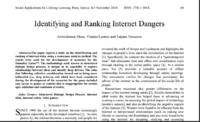Identifying and Ranking Internet Dangers: Difference between revisions
No edit summary |
No edit summary |
||
| Line 4: | Line 4: | ||
|authors=[[Aristodemou Elena]], [[Yiannis Laouris]] & [[Romina Laouri]] | |authors=[[Aristodemou Elena]], [[Yiannis Laouris]] & [[Romina Laouri]] | ||
|journal=Social Applications for Lifelong Learning | |journal=Social Applications for Lifelong Learning | ||
| | |issn=1792-586X | ||
|pages=68 - 76 | |pages=68 - 76 | ||
|year=4-5 November 2010 | |year=4-5 November 2010 | ||
Revision as of 08:36, 22 November 2023
|
Abstract
The paper reports a study on the identification and ranking of internet risks, using a root-cause analysis method. The results were used for the development of scenarios for the Simsafety Game™. The methodology used, known as structured dialogic design process, is unique in its capability to explore relationships between ideas and identify deep drivers. The risks that following collective consideration turned out as being more influential (i.e., deep drivers), and which have been considered during the development of the scenarios for the game included easy access to games or content that is inappropriate for certain ages, addiction and confusion of reality.
Citation
Laouris, Y., Emiliani, P. L., & Roe, P. (2017). Systemic evaluation of actions toward developing practical broadband applications for elderly and people with disabilities. Universal Access in the Information Society, 16, 247-255.
